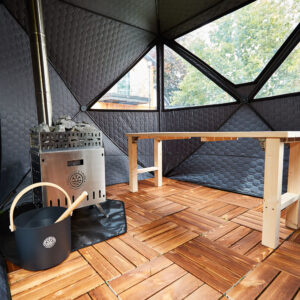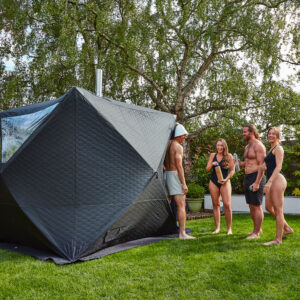
Ice Baths: A Key to Enhanced Recovery and Vitality for Athletes
Explore how ice baths can boost recovery and enhance vitality for athletes. Discover practical tips and insights to elevate your performance. Read more!
Christmas Delivery: UK orders by 10am, 19th Dec. Ireland/EU by 12pm, 15th Dec. Dispatch resumes 2nd Jan.
Spend Over £500 To Get Free UK Delivery - Excludes Certain Postcodes & Round Ice Baths
Delivery to Ireland now available

Want to enjoy a water feature in your garden without much hassle? A stock tank pond might be the perfect solution. This article will walk you through how to set up and maintain a stock tank pond, providing essential steps and tips along the way.
Choose the right size and material for your stock tank to ensure a healthy and stable ecosystem for fish and plants.
Create a balanced pond environment by incorporating diverse plant types and maintaining water quality through regular cleaning and monitoring.
Enhance your pond’s beauty and function with water features, natural elements, and seasonal preparations to support wildlife and improve aesthetics.

Creating the perfect stock tank pond begins with selecting the right stock tank, a choice that directly impacts your pond’s health and stability. Available in various sizes and shapes, such as circular and oval, stock tanks suit different designs and space constraints. The tank’s size influences the water volume, affecting the number of fish it can support and the ecosystem’s stability.
A larger stock tank tends to support a more stable ecosystem, leading to better water quality and healthier fish. This stability is vital if you plan to keep various plants and fish in your pond. Proper water conditions are crucial for the well-being of your pond’s inhabitants.
Following a series of steps—from selecting the right location to maintaining optimal water conditions—will help you create a vibrant and thriving stock tank pond. Learn how to choose the right stock tank and set up your pond to create a stunning water feature that will be the envy of your neighborhood.
Stock tanks have been creatively utilized by gardeners for many years, not just for watering livestock but also as attractive water features and vegetable garden containers. These versatile containers have found a new life in urban and suburban gardens, where space is often at a premium. A stock tank pond allows you to enjoy the benefits of a water feature without the need for a large yard or complex setup.
Creating a stock tank pond is an excellent way to bring a piece of nature into your yard. These ponds are compact and manageable, making them ideal for smaller garden spaces. Whether placed in a sunny corner of your yard or nestled among your flower beds, a container pond can add a touch of tranquility and beauty to any outdoor area.
With the ability to support a variety of plants and fish, stock tank ponds are not only aesthetically pleasing but also beneficial for the environment. They provide a habitat for local wildlife, help to cool the surrounding area, and even offer a relaxing spot for you to enjoy.
Creating your own stock tank pond can be both easy and rewarding, as you’ll discover through the following steps.

The foundation of a successful pond project starts with choosing the right stock tank. Available in various sizes and shapes, such as circular and oval, stock tanks can suit different garden designs and space constraints. The tank’s size affects the water volume, which influences the pond’s ecosystem stability and the number of fish it can support.
Material is another important factor when selecting a stock tank. Galvanized metal tank are popular due to their durability and safety for fish, as the coating does not leach harmful substances into the water. Plastic tanks, being lighter and easier to handle, are also a viable option.
The placement of your tank is another crucial factor. Ideally, it should be in a location that balances sunlight and shade to maintain optimal water temperatures for fish.
Let’s explore these considerations in more detail to help you make the best choice for your stock tank pond.
Your stock tank’s size significantly impacts the health and stability of your pond’s ecosystem. Larger tanks generally support more stable ecosystems, resulting in better water quality and healthier fish, as the increased water volume can more effectively dilute toxins and provide a consistent environment for aquatic life.
If you plan to grow water lilies and house fish, a stock tank with a depth of at least 2 feet is recommended. This depth allows water lilies to thrive and provides ample space for fish to swim comfortably. Additionally, deeper tanks help maintain more stable temperatures, essential for the health of your pond’s inhabitants.
When selecting the size of your stock tank, consider the types of plants and fish you want to keep. Larger tanks support more diverse ecosystems and offer greater flexibility in pond design.
For material options, galvanized metal and plastic are the most common choices. Galvanized metal tanks are durable and safe for fish, as the coating does not leach harmful substances into the water. These tanks are also resistant to rust and corrosion, providing a long-lasting option for your pond.
Plastic stock tanks are lighter and easier to move compared to metal ones. Available in various sizes and shapes, they offer more flexibility in pond design. Both materials have their advantages, and the choice depends on your personal preferences and your pond’s specific needs.
Positioning your stock tank correctly is crucial for maintaining a healthy and stable pond ecosystem. Ideally, place your tank where it receives a balance of sunlight and shade. Excessive direct sunlight can overheat the water, stressing the fish and promoting algae growth, while partial shade can help prevent overheating, especially in warmer climates.
Choosing a spot that receives morning sun and afternoon shade is often ideal. This setup helps maintain a suitable temperature for fish and supports the growth of aquatic plants.
Make sure the area is level and stable to prevent tilting as the tank fills with water.

Setting up your stock tank pond involves key steps to ensure a stable and healthy environment for plants and fish. Start by preparing a solid base for the tank, ensuring a stable foundation to prevent tilting and promote pond longevity.
Fill the tank with water and allow it to dechlorinate before adding any plants or fish. Adding a substrate like gravel or lava rock at the bottom will support plant growth and help maintain water quality.
Following these steps will help you create a thriving stock tank pond, providing a beautiful and functional water feature for your garden.
A stable base is essential for the longevity and functionality of your stock tank pond. Start by digging out the ground beneath the tank and filling it with self-leveling materials like sand or pea gravel to provide drainage and prevent shifting over time.
Using decomposed granite or paver base can also ensure stability and prevent tilting as the tank fills with water. Creating a solid foundation sets the stage for a successful and long-lasting pond.
Before adding fish or plants, fill your stock tank with water and let it sit for at least 24 hours to allow the chlorine to evaporate. Chlorine and other chemicals in tap water can harm aquatic life, making this step crucial for creating a safe environment.
If possible, let the water sit for several days to ensure complete dechlorination. This process helps create a stable environment for your plants and fish, promoting their health and well-being.
Adding a substrate like gravel or lava rock to the bottom of your stock tank pond supports plant growth and enhances water quality. These materials provide a surface for beneficial bacteria to colonize, helping break down organic waste and maintain a healthy ecosystem.
Incorporating substrate also creates a more natural environment for your plants and fish, encouraging them to thrive in their new habitat.

Planting your stock tank pond is crucial for creating a balanced and thriving ecosystem. A mix of oxygenating plants, marginal plants, and floating plants achieves this balance. Oxygenating plants maintain water quality and control algae; marginal plants offer natural filtration and aesthetic appeal, while floating plants like water lilies provide shade and help regulate water temperature.
Incorporating a variety of plant types helps create a beautiful and functional pond that supports the health of your aquatic life.
Oxygenating plants are vital for maintaining your pond ecosystem’s health. They produce oxygen, control algae, and improve water quality. Anacharis is a popular choice for stock tank ponds due to its effectiveness in supporting aquatic life.
Incorporating oxygenating plants in your pond helps create a balanced environment where fish and other aquatic life can thrive.
Marginal plants, like cattails and irises, offer both aesthetic beauty and effective natural filtration for your pond. Growing along the edges, these plants help filter out impurities, maintaining a clean and healthy environment.
Dwarf papyrus and dark-leaved pond crinum are excellent choices for marginal planting, adding visual interest and supporting the pond’s ecosystem.
Floating plants are essential for maintaining a balanced pond ecosystem. They provide shade, regulate water temperature, and reduce sunlight penetration, thereby controlling algae growth. Water lilies and duckweed are excellent choices for stock tank ponds, offering both aesthetic appeal and environmental benefits.
Floating on the water’s surface, these plants create a natural habitat for fish and other aquatic life. Incorporating more floating plants enhances your pond’s beauty and functionality while supporting a healthy ecosystem.
Adding fish to your stock tank pond brings life and movement, creating a dynamic water feature. Fish also help maintain the pond’s ecosystem by eating algae and mosquito larvae, keeping the water clean. Choosing the right fish, acclimating them properly, and providing adequate care are essential for a thriving fish population.
Let’s explore the best fish choices, how to acclimate them, and tips for feeding and caring for your fish.
Before:
For stocking your pond, hardy fish like goldfish, mosquito fish, and koi are excellent choices. Goldfish prefer cooler water and can adapt to various conditions, making them popular for stock tank ponds. Mosquito fish help control mosquitoes by feeding on larvae, while koi add color and grace to the pond.
After:
For stocking your pond, consider these hardy fish:
Goldfish, which prefer cooler water and can adapt to various conditions, making them popular for stock tank ponds
Mosquito fish, which help control mosquitoes by feeding on larvae
Koi, which add color and grace to the pond
Before add fish, check with your supplier to determine how many your pond can support based on its size and water volume. This ensures a balanced ecosystem and healthy fish population.
Proper acclimation is crucial to minimize stress and temperature shock when introducing new fish to your pond. Start by floating the fish bags in the pond water for about 20 minutes to equalize temperatures, helping the fish adjust to their new environment and reducing stress and health risks.
The acclimation process can last between 15 to 60 minutes, depending on the temperature difference and the species of fish. Taking the time to acclimate your fish properly ensures a smooth transition and a healthy start in their new home.
Feeding your fish is an important part of ensuring they remain happy and healthy in your stock tank pond.
Goldfish, for example, forage on:
mosquito larvae
algae
bugs
anacharis
This foraging behavior helps keep the pond clean. Regular observation of fish behavior can help detect any issues early, ensuring timely care and intervention.
Maintaining a clean environment and providing a balanced diet is crucial for long-term fish health. Overfeeding should be avoided, as excess food can decompose and harm water quality.
Regular water changes and monitoring will keep your fish healthy and your pond water clean.
Maintaining water quality is essential for the health and longevity of your stock tank pond. Several factors, including temperature, sunlight exposure, and the presence of a recirculating pump, can influence water quality. Implementing regular cleaning routines, managing algae levels, and making seasonal adjustments are key to keeping your pond in top condition.
Let’s delve into the specifics of these maintenance tasks to ensure your pond remains a healthy and vibrant environment for your plants and fish.
Regular removal of leaf litter and debris is crucial to prevent contamination and maintain a healthy environment for aquatic life. Use a pond net or rake to scoop out floating debris and leaves from the surface of the water. For submerged debris and sediment, consider using a vacuum designed specifically for pond cleaning.
To minimize the amount of debris entering your pond, place netting or mesh covers over the pond during windy seasons. Regular cleaning keeps your pond crystal clear and supports a healthy ecosystem.
Managing algae levels is crucial for maintaining a healthy ecosystem in your stock tank pond. Utilizing barley straw is an effective natural method for controlling algae growth. Beneficial bacteria treatments can also help reduce algae by breaking down organic waste in the pond.
Regular testing of water parameters and controlling light exposure can significantly reduce algae growth, ensuring clean water and a balanced ecosystem.
Seasonal changes can affect water temperature and quality, requiring adjustments in maintenance routines. Cleaning routines should be modified seasonally to accommodate changes in plant growth and debris accumulation. Adjusting the amount of light and water changes in winter can help maintain water quality during colder months.
Insulating the stock tank helps delay the water from freezing, ensuring your pond remains a healthy environment year-round.

Enhancing your stock tank pond can significantly boost its aesthetic appeal and functionality. Adding water features, bird and insect platforms, and decorative elements can transform your pond into a focal point of your garden. These enhancements not only improve the visual charm of your pond but also support local wildlife and biodiversity.
Let’s explore some creative ways to enhance your stock tank pond and make it a standout feature in your outdoor space.
Installing a drip-faucet fountain or a bubbler can enhance both water aeration and visual charm in a stock tank pond. Pumps and fountains improve oxygen levels, which is beneficial for fish and plant life.
These water features create a soothing ambiance and can help maintain clean water by promoting circulation and preventing stagnation.
Adding platforms for birds and insects can enhance the ecological balance of your pond. A stone bathing platform on a cement block provides a stable area for birds and insects to access water, promoting biodiversity. These structures serve as drinking spots and habitats, benefiting both the aquatic and aerial ecosystems.
Implementing such platforms can attract diverse wildlife to your pond, creating a vibrant and dynamic environment.
Incorporating natural elements like stones and driftwood can create visual interest and a natural feel in your stock tank pond. Larger stones provide a naturalistic look and create habitats for aquatic life, while driftwood adds texture and character.
Aquatic ornaments such as statues, fountains, or decorative rocks can serve as focal points, enhancing the beauty and harmony of your pond area.

Winterizing your stock tank pond is essential to protect plants and fish from freezing temperatures. Preparing your pond for winter includes insulating the tank, using a deicer, and protecting your plants and fish. These steps ensure that your pond remains a healthy and vibrant environment even during the colder months.
Let’s explore the key actions needed to winterize your stock tank pond effectively.
Creating an inch or two of dead air space between the tank sides and cold air effectively insulates the tank. Using a black stock tank can enhance heat absorption, delaying ice formation. Additionally, a floating object can help delay icing by creating ripples on the water surface.
Insulating the tank helps maintain a stable water temperature, protecting your pond’s ecosystem during cold winters.
Using a pond deicer is crucial for maintaining a hole in the ice, enabling gas exchange for fish. The K&H Thermo-Pond deicer can sustain a hole in the ice for ponds at least 18 inches deep, ensuring your fish have access to oxygen.
A deicer helps prevent your pond from freezing solid, protecting your fish and maintaining water quality during winter.
Moving certain pond plants indoors helps ensure their survival through winter. Trimming back annual growth is a recommended step for preparing pond plants for winter. Overwintering pond plants is essential for maintaining your pond’s ecosystem in the spring.
Ensure that fish have access to sufficient open water and oxygen to survive the cold months. Regular checks and maintenance will keep your pond healthy and ready for spring.
Creating and maintaining a stock tank pond is a rewarding project that brings beauty and tranquility to your garden. From choosing the right tank and setting it up to planting, adding fish, and ensuring water quality, each step is crucial for a thriving pond. Enhancing your pond with water features and preparing it for winter ensures its longevity and health.
By following these tips and tricks, you can enjoy a beautiful and functional stock tank pond that supports local wildlife and provides a serene escape in your own backyard. Start your pond project today and transform your outdoor space into a peaceful oasis.
For the best pond experience, choose a stock tank that is at least 2 feet deep. This depth will create a stable environment that supports vibrant water lilies and happy fish, ensuring a thriving ecosystem.
To successfully acclimate your fish, float their bags in the pond for about 20 minutes to equalize temperatures, then gently release them to reduce stress. This simple process helps ensure your fish thrive in their new home!
For a thriving stock tank pond, include a mix of oxygenating plants like Anacharis, marginal plants such as cattails and irises, and floating plants like water lilies. This combination will enhance water quality, provide natural filtration, and keep algae in check!
To maintain water quality in your pond, regularly clean it by removing debris and managing algae levels while also adjusting your maintenance routines with seasonal changes. Embracing these practices will help keep your pond vibrant and thriving!
To successfully winterize your stock tank pond, insulate the tank and use a deicer to keep a hole in the ice for oxygen. Additionally, bring certain plants indoors and trim annual growth to ensure your pond’s ecosystem thrives through the winter!

Founder of Urban Ice Tribe

Explore how ice baths can boost recovery and enhance vitality for athletes. Discover practical tips and insights to elevate your performance. Read more!

There’s nothing quite like the raw, elemental power of a pop-up sauna. Portable, authentic, and deeply restorative, it’s the perfect way to reconnect with nature and yourself. But to take your sauna ritual to the next level, the right sauna accessories can make all the difference.

Transform your outdoor space into a personal wellness retreat with the Urban Ice Tribe Sauna Tent. This detailed setup guide walks you through every step, from unboxing to your first steam session, blending practical instruction with the mindful ritual of heat therapy.
Helping men & women release anxieties & limiting beliefs to experience a life of freedom using powerful breathwork, cold water therapy, movement & sound healing.

No spam, notifications only about new products, updates, offers and announcements.